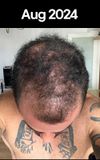community Hair treatment with topical kirkland minoxidil, 1 capsule of 1000mg pumpkin seed oil, 2 tablespoons of coconut oil daily
.
This conversation was about hair loss treatments, with suggestions ranging from topical minoxidil and coconut oil to finasteride and microneedling. Several users suggested shaving off the remaining hair as a last resort.

